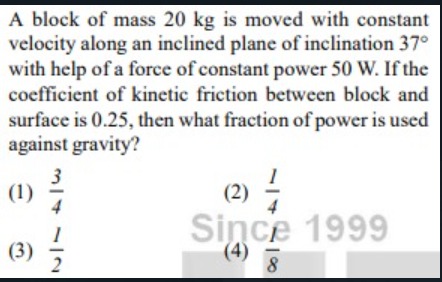Question
Question: A block of mass 20 kg is moved with constant velocity along an inclined plane of inclination 37° wit...
A block of mass 20 kg is moved with constant velocity along an inclined plane of inclination 37° with help of a force of constant power 50 W. If the coefficient of kinetic friction between block and surface is 0.25, then what fraction of power is used against gravity?

A
43
B
41
C
21
D
81
Answer
43
Explanation
Solution
The power used to overcome gravity is given by:
Pgravity=mgsinθ×v- The total power output must overcome both gravity and friction:
- The fraction of power used against gravity is:
- With θ=37∘ (sin37∘≈0.6,cos37∘≈0.8) and μ=0.25:
